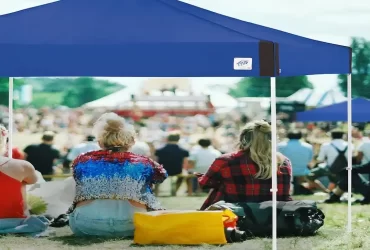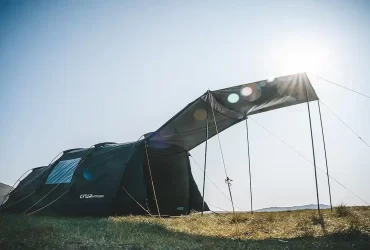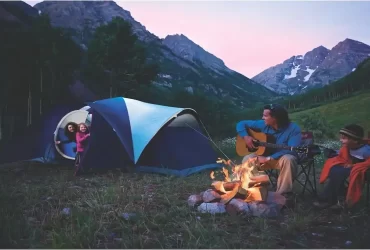Traveling is the ultimate budget killer without a doubt, and accommodations are no exception. You almost have to pack it if you intend to backpack in the world’s most expensive areas (Australasia, North America, Western Europe, etc.). This is why it is an absolute must to pack a tent when backpacking.
Budget backpacking tents are difficult to find when searching for them online. The market is filled with plenty of information and options to consider. Cost-savings without compromising quality are major considerations. Your goal is likely to find a balance between cost-effectiveness and performance. Here we list some of the best backpacking budget tents on the market, highlighting a few of the most important factors.
1. Kelty Tents Kelty Discovery Trail Backpacking Tent

The tent is reasonable in price and lightweight for its spacious interior (two average-sized men would be able to stay comfortably in it). In addition, it is easy to assemble. A backpacking tent tends to have a pole inserted into a grommet at one corner, and then the pole is bent when the other end is inserted into the grommet. This has to be done a few times because the pole slips out of one or both grommets.
Each corner of the Kelty Discovery Trail tent has nylon-webbing pouches rather than grommets, preventing poles from falling out during setup. Additionally, the tent body corners were color-coded with the fly, which made it considerably easier to line up.
Kelty Discovery Trail 2 had a spacious vestibule, extra stakes, vents along the rainfly, and pockets for storage within, despite not having a second door as a two-person tent should. Although this tent showed a few very small holes during an abrasion test, you should still carry the Kelty Discovery Trail footprint. Approximately five pounds weighed the Kelty Discovery Trail 2.
Also like this:
2. THE NORTH FACE Stormbreak 2 Backpacking Tent

North Face products are known for their reliability and are among the best in the industry. This backpack is perfect for budget backpackers because it is compact, comfortable, and affordable. Like most two-person tents, the North Face Stormbreak tends to run large. Because the walls are high angle, you will not have to worry about your head scraping the canopy when you sit up.
You are in the middle of a weeklong backpacking trip. There are sweat stains on your clothes, and your feet smell, and you are many days away from a hot shower. Using high-low ventilation, no smells stay longer than necessary in the tent because airflow is efficient. It’s also important to maintain constant ventilation on warm nights, and to keep heat in the tent on cold nights.
3. Hubba Hubba 2-Person Backpacking Tent

The tent’s material is top-notch and of trademark MSR quality; this thing is built to last (excluding any guerrilla assaults from subterranean sources). It has double doors, double vestibules (and MSR does good vestibules), and my favourite ‘this shouldn’t impress me as much as it does’ feature a glow-in-the-dark zipper!
I know the price of this tent is probably giving some of you a heart attack. I took the MSR Hubba Hubba on a 45-day backpacking expedition in the Arctic. This tent stood above and beyond all the elements. So this goes beyond a suggestion, its a personal recommendation. If you have purchased any MSR products before, then you know that their exceptional quality is here to stay.
4. Big Agnes C-Bar Backpacking Tent

Among budget backpacking tents, the Big Agnes C Bar 2 weighs just four pounds, making it one of the lightest options. The oversized ceiling pocket opens to a vestibule where you can store gear, plus two mesh pockets for random bits and pieces. Despite poor weather conditions, it sets up easily and has a waterproof fly and floor.
It is often the case that weight savings come at the expense of comfort. One-person tents are more popular than two-person tents because of their spaciousness. This lightweight budget tent may be right for you if you plan to spend more time hiking than hanging out in it.
Also like this:
5. Marmot Fortress 3P Lightweight Tent

Although it is a bit more expensive than the other tents on this list, the Marmot Fortress is still much less expensive than a standard winter tent. For entry-level winter adventures, the Marmot Fortress provides plenty of protection without breaking the bank, and it won’t keep you from adventuring.
After extensive adjustments to the tensioner system at the pole ends, the tent was still not able to maintain a taut structure. It is important to note that, unlike most backpacks, the Marmot Fortress requires you to first assemble the guylines before you can use it. For the first few excursions, an individual should not stake out or guyline this tent above treeline until he or she is familiar with its setup and guylining.
6. Sierra Designs Lost Coast 2 Backpacking Tent

Backpacking tents with a low price tag are often heavier than their higher-end counterparts. This test found that Sierra Designs Lost Coast tent was the lightest and least expensive (despite its claimed weight not matching its measured weight). Lost Coast tents by Sierra Designs are lightweight in part because they are smaller.
A 50-inch tent will only fit two backpacking sleeping pads, so if you plan to share it with someone, make sure you’re fine with cuddling. While Sierra Designs Lost Coast had some small design issues, setting it up was relatively straightforward. It was the only tent in the test where the top clip could only grab one cross pole. The rainfly was not covered, which was more concerning.
Upon cinching down the tent’s corners, the mesh along the back and a side was visible. Rainfly tensioners were evenly distributed on all sides, which solved the problem, but for inclement weather, the shorter rainfly will be more challenging to set up. Abrasion test results indicate that you may have to pay an extra few dollars if you plan to camp in deserts or on rocky surfaces.
7. Black Diamond Equipment Mega Light 4P Tent

The Black Diamond Mega Light is better described as a shelter than a tent. Black Diamond is a four-season shelter with a somewhat budget-friendly price tag. A wind test of 50 mph showed that it can withstand winter conditions (though there will be a bit of a draft due to the lack of a floor).
Therefore, it is an ideal option for a cheap ultralight tent that can be used in any weather condition. With a floor/bug netting purchased separately, it adds another 3.5 lb (1.6 kg) to its weight. In addition, the shelter is large enough to sleep four people, measuring 50.7 square feet (4.7m2).
Even though it’s not stealthy, it’s a spacious tent if you’re into urban camping. In addition, it can also be supported with a trekking pole instead of its own travel pole. Regardless of the weather conditions, it will suit crews of any size. However, the downside is that you have to pay an extra premium for the versatility of use – along with no flooring.
Also like this:
FAQs
How do camping tents and backpacking tents differ?
Backpacking tents differ from camping tents primarily by their weight and size. While camping tents commonly have a larger footprint (typically measured as one, two, or three people), backpacking tents are typically lighter and smaller.
Is there a weight limit on backpacking tents?
Backpacking tents can weigh as little as one pound per person, but the upper end is less well defined. You could carry almost anything if you plan to backpack just a mile to camp. As a general rule, if you’re planning on hiking more than 15 miles in a day, your tent should weigh between two and four pounds per person.
Is it a good idea to use a footprint when backpacking?
Footprints are recommended with backpacking tents if the manufacturer recommends them, since all tent floors are not designed equally. For backpacking trips in volcanic areas and high deserts, you may also wish to use a footprint for the tent if you will be camping on rocks or rough surfaces.





Leave a Reply
View Comments